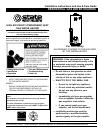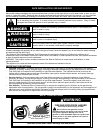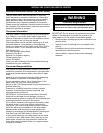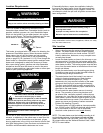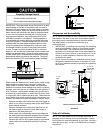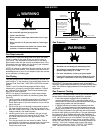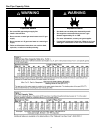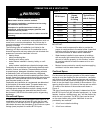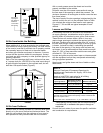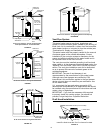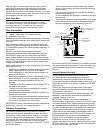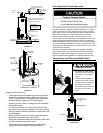
8
IMPORTANT: The water heater should be located in an area
where leakage of the tank or connections will not result in
damage to the area adjacent to the water heater or to lower
floors of the structure. Due to the normal corrosive action of
water, the tank will eventually leak after an extended period
of time. Also any external plumbing leak, including those
from improper installation, may cause early failure of the
tank due to corrosion if not repaired. If the homeowner is
uncomfortable with making the repair a qualified technician
should be contacted. A suitable metal drain pan should be
installed under the water heater as shown below, to help
protect the property from damage which may occur from
condensate formation or leaks in the piping connections
or tank. The pan must limit the water level to a maximum
depth of 1-3/4” and be two inches wider than the heater and
piped to an adequate drain. Locate the water heater near a
suitable indoor drain. Outside drains are subject to freezing
temperatures which can obstruct the drain line. The piping
should be at least 3/4” ID and pitched for proper drainage.
1-3/4”
max.
At least 2” greater
than the water heater.
Pipe to an
adequate drain
Water heater life depends upon water quality, water usage,
water temperature and the environment in which the
water heater is installed. Water heaters are sometimes
installed in locations where leakage may result in property
damage, even with the use of a metal drain pan piped to a
drain. However, unanticipated damage can be reduced or
prevented by a leak detector or water shut-off device used
in conjunction with a piped metal drain pan. These devices
are available from some plumbing supply wholesalers and
retailers, and detect and react to leakage in various ways:
• Sensors mounted in the metal drain pan that trigger an
alarm or turn off the incoming water to the water heater
when water is detected.
• Sensors mounted in the metal drain pan that turn off
the water supply to the entire home when water is
detected in the metal drain pan.
• Water supply shut-off devices that activate based on
the water pressure differential between the cold water
and hot water pipes connected to the water heater.
• Devices that will turn off the gas supply to a gas water
heater while at the same time shutting off its water
supply.
REVERSE FLOW
OF GASES
EXHAUST FAN
FIGURE 2.
Clearances and Accessibility
NOTE: Minimum clearances from combustible materials
are stated on the label on the front of the heater adjacent
to the gas control valve/thermostat of the water heater.
The water heater is certified for installation on a
combustible floor.
• IMPORTANT: If installing over carpeting, the carpeting
must be protected by a metal or wood panel beneath
the water heater. The protective panel must extend
beyond the full width and depth of the water heater by
at least five inches (127mm) in any direction; or if in an
alcove or closet installation, the entire floor must be
covered by the panel.
• Figure 2A may be used as a reference guide to locate
the specific clearance locations. A minimum of 5 inch-
es of front clearance should be provided for inspection
and service.
Ceiling
Top View
Minimum Clearance Locations
0” min.
Back
0” min.
Sides
5” min.
Front
12” min.
Top to
6” min. at
Single Wall
Vent Pipe
0” min.
Air Inlet
Chamber
FIGURE 2A.
State of California
NOTE: The water heater must be braced, anchored, or
strapped to avoid moving during an earthquake. Contact
local utilities for code requirements in your area, visit http://
www.dsa.dgs.ca.gov, or call 1-916-445-8100 and request
instructions.
FIGURE 1B.



